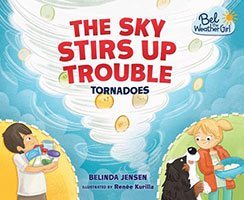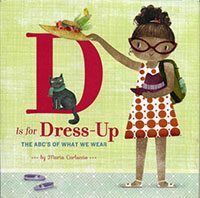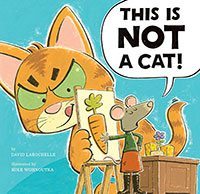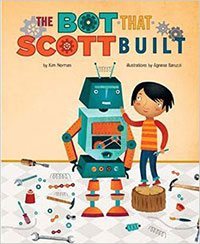Warning: There’s a lot of enthusiasm ahead for these books!
 Where Do Pants Go?
Where Do Pants Go?
Written by Rebecca Van Slyke, illustrated by Chris Robertson
Sterling Children’s Books, 2016
Well, this is just adorable … and I can already hear households throughout the English-speaking world chanting:
“Where do pants go?
On your arms? No.
On your neck? No.
No, no, no.
Pants go on your legs, that’s where pants go.”
We all know how much kids love saying “NO!” This book depicts a charming cast of kids in a rowdy lesson on getting dressed from underwear to jacket and hat. It’s a cumulative text so language skills are a part of the mix. The illustrations are bouncy and full of humor. Getting dressed will be filled with giggles.
 The Sky Stirs Up Trouble (Tornadoes)
The Sky Stirs Up Trouble (Tornadoes)
written by Belinda Jensen, illustrated by Renee Kurilla
Millbrook Press, 2016
I wonder if a scientific study has ever been done to determine how many kids want to grow up to be the weather forecaster on local or national news. Certainly the weather is just as much a preoccupation for children as it is for adults. This brand-new, six-book series about Bel the Weather Girl is written by a television meteorologist with an eye toward entertaining and educating the reader. In this book, Bel and her cousin Dylan head to the basement with Bel’s mom when a tornado siren goes off. They learn how to react to the warning and Bel explains, by baking a Tornado Cake, how the atmospheric conditions must be just so in order to cook up a tornado. A recipe for the cake is included as are interesting fact bubbles. The illustrations are friendly and engaging. I know I would have read and re-read this series in elementary school.
 D is for Dress Up: The ABCs of What We Wear
D is for Dress Up: The ABCs of What We Wear
written and illustrated by Maria Carluccio
Chronicle Books, 2016
This charming alphabet book is just right for someone who will grow up to collect fabric, carefully study fashions, and find joy in creating “a look.” A wonderfully diverse group of children are dressed in clothing and accessories that depict each word from apron (for a chef) to zippers (for two friends’ jackets). In between, we find leotards and overalls and raincoats. It’s the illustrations that are most inviting: so much for the eyes and brain and heart to notice and absorb. There’s texture and pattern and detail (notice those galoshes) created by a textile and product designer resulting in a warm and enchanting book. You’ll know just the child to give it to.
 This is NOT a Cat!
This is NOT a Cat!
written by David LaRochelle, illustrated by Mike Wohnoutka
Sterling Children’s Books, 2016
LaRochelle and Wohnoutka (Moo!) are at it again: a book that has very few words but a lot of laughs! I love these books with few words because kids are so good at telling the story themselves. With gentle prompting from the adult reading with them, kids can be encouraged to tell the story in different ways. Perhaps the most fun is saying the five words in the book in so many different ways with varying emphasis and LOUDness! It’s just plain fun to read this book out loud. And because there are only five words, every child can have the satisfaction of reading this book on their own. The lively, humorous pictures conceived by Mike Wohnoutka invite studying closely as the details add to the fun. Bring your own knowledge to this book: do cats like cheese?
 The Bot That Scott Built
The Bot That Scott Built
written by Kim Norman, illustrated by Agnese Baruzzi
Sterling Children’s Books, 2016
Great Scott! I love this book. For any child the least bit science-minded who loves to experiment or build things or creatively compile what-ifs, this is a must-have book. It’s an awe-inspiring feast for the eyes and the ears and the funny bone. The setting is a Science Day, in which students show their science projects to their teacher and the rest of the class. In a House That Jack Built style, the “what can go wrong, does” story progresses with much laughter thanks to the spot-on rhyming text and the color-infused illustrations. The ending is ingenious. I won’t spoil it for you and your smaller readers. But Scott’s science project saves the classroom from the brink of destruction. I’m inspired to make my own “bot” right now and so will you be!
